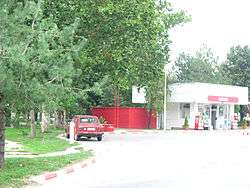Sečanj
| Sečanj Сечањ | |
|---|---|
| Municipality and Town | |
|
The new Orthodox Church. | |
 Sečanj Location of Sečanj within Serbia | |
| Coordinates: 45°22′00″N 20°46′21″E / 45.36667°N 20.77250°ECoordinates: 45°22′00″N 20°46′21″E / 45.36667°N 20.77250°E | |
| Country | Serbia |
| Province | Vojvodina |
| District | Central Banat |
| Government | |
| • Mayor | Predrag Milošević |
| Area | |
| • Sečanj | 523 km2 (201.9 sq mi) |
| Population (2011) | |
| • Sečanj | 2,373 |
| • Metro | 13,267 |
| Time zone | CET (UTC+1) |
| • Summer (DST) | CEST (UTC+2) |
| Postal code | 23240 |
| Area code(s) | +381(0)23 |
| Car plates | ZR |



Sečanj (Serbian Cyrillic: Сечањ) is a village and municipality in Central Banat District of Vojvodina, Serbia. The village has a population of 2,373, while the Sečanj municipality has 13,267 inhabitants.[1]
Name
"Sečanj" is a Slavic name for the first month in the calendar year. The Serbian Ekavian variant of this name was eventually replaced with the new word "Januar" (corresponding to the common months as known in Western European cultures), while the Croatian Ijekavian variant "Siječanj" remains in use in Croatia.
In Serbian, the village is known as Сечањ or Sečanj, in Hungarian as Szécsány or Torontálszécsány, in German as Setschan or Petersheim, in Croatian as Sečanj, and in Romanian as Seceani.
Serbian, Hungarian, and Romanian language are officially used by municipal authorities.

Historical population of the village
- 1837: 1,489
- 1900: 2,596
- 1961: 2,829
- 1971: 2,906
- 1981: 2,718
- 1991: 2,688
- 2002: 2,647
- 2011: 2,104
Inhabited places
The Sečanj municipality includes the town of Jaša Tomić and the following villages:
- Sečanj
- Banatska Dubica
- Boka
- Busenje (Hungarian: Káptalanfalva)
- Jarkovac
- Konak
- Krajišnik
- Neuzina
- Sutjeska
- Šurjan
Ethnic groups (2011 census)
According to the 2011 census Sečanj municipality had 13,267 inhabitants, including:[1]
- Serbs = 9,195 (69.31%)
- Hungarians = 1,691 (12.75%)
- Romani = 714 (5.38%)
- Romanians = 566 (4.27%)
- Others and undeclared = 1,101 (8.30%)
The settlements with Serb ethnic majority are: Sečanj, Banatska Dubica, Boka, Jarkovac, Jaša Tomić, Krajišnik, and Sutjeska. The settlement with Hungarian ethnic majority is Busenje. Ethnically mixed settlements with relative Serb majority are: Konak, Neuzina and Šurjan.
References
- Slobodan Ćurčić, Broj stanovnika Vojvodine, Novi Sad, 1996.
- 1 2 "Population by ethnicity – Sečanj". Statistical Office of the Republic of Serbia (SORS). Retrieved 4 March 2013.
See also
| Wikimedia Commons has media related to Sečanj. |



